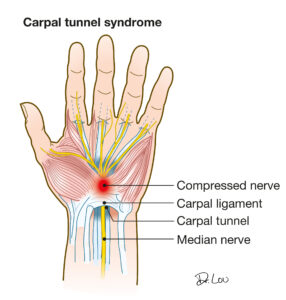Carpal Tunnel Syndrome And The Guitarist
Prevention. Management. Healing.
In this brief post, you will learn about the anatomy of the carpal tunnel, what carpal tunnel syndrome (CTS) does to the guitarist, and how to prevent, manage and treat CTS yourself.
The carpal tunnel is a band of ligamentous tissue that traverses the wrist. Think of it as a stretchable bridge over a stream. Underneath the carpal tunnel ligament, also known as the “Flexor Retinaculum” or “carpal ligament”, is where your forearm and finger tendons live. It is also where the nerves and blood vessels run along side one another to nourish and control your hands. All of these structures are packed pretty tightly through the wrist, under the flexor retinaculum. Carpal tunnel syndrome occurs when inflammation due to repetitive stress, or scar tissue and adhesion due to repetitive stress accumulates under the flexor retinaculum. This is one of the more common playing related musculoskeletal disorders or PRMD’s in guitarists and bassists. Beyond pain, numbness, tingling and even weakness may occur in the hands and fingers. Loss of dexterity, and even muscle loss may occur in severe cases.

Carpal Tunnel Syndrome can kill careers. Dr. Lou can coach you through.
The surgical treatment of this involves cutting the flexor retinaculum and sewing it back together looser, so that the structures beneath have more room to move, which allows the inflammation to settle down. The problem is, scar tissue forms, and if the surgery fails, you’ll be dealing with it for a long time, and it will interrupt your playing.
Before seeking surgical help, there is a lot that can be done to help.
-Proper warm ups, which could include actual heat on the affected area before playing.
-Avoiding activities outside of playing that involve repetitive wrist movements and rapid finger movements.
-Don’t sleep on your hands and wrists. Curling your wrists to your chest will perpetuate CTS. (Link: The best sleep position for musicians)
-Take breaks while playing.
-Ice the underside of your wrists after playing.
-Stretch your wrists and forearms regularly.
Remember “The 5 P’s” – Proper Planning Prevents Poor Performance. If you are capable of preparing by practicing so that you don’t get kicked out of the band or look like an idiot on stage, then you can spend a few minutes a day to protect your “hand tools.”
The 6 steps above are preventive, healing, and capable of managing worsening CTS.
Dr. Lou has worked regularly with musicians and their crews for over 20 years. Because of the nature of the issues, tele-chiro calls are effective in many cases for assessing the problems and creating a plan of action for home care, before a physical visit to a doctor is necessary. Shoulder pain of muscular origin is often manageable with home care. To reach Dr. Lou and his team, call (207) SPINAL-1
